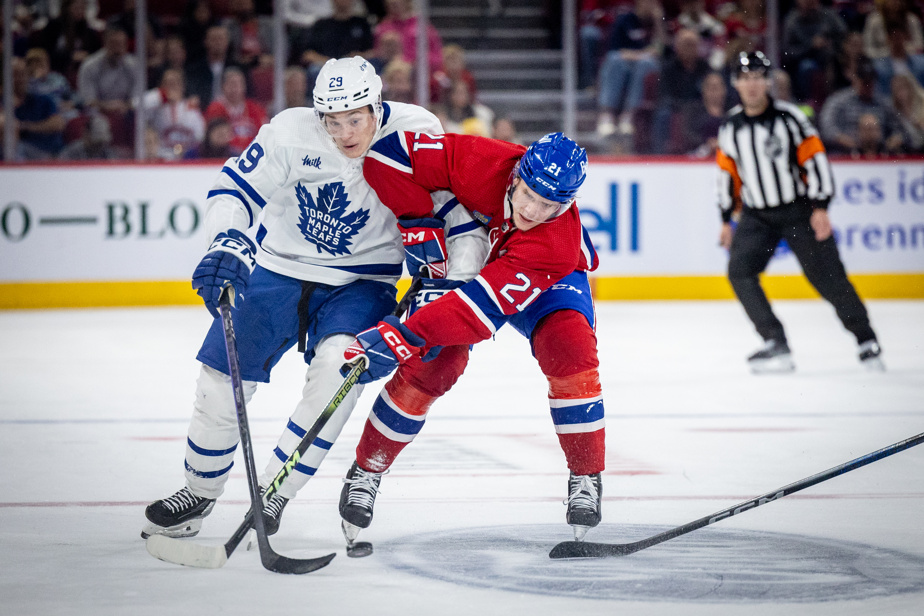Kaiden Guhle is not the most demonstrative player; Lyle Odelein, he is not. So his big smile after his goal in the third period of Saturday’s game was hard to ignore.
It appears that the goal was the result of a planned play. Alex Newhook won the faceoff and sent the puck behind him to Johnathan Kovacevic. As soon as Guhle noticed the puck was heading towards Kovacevic, he took a few strides forward and was positioned for a quality shot, which hit the target.
A few seconds earlier, on the previous throw-in, also in the Leafs zone, Guhle had noticed that the Torontonians were exerting strong pressure on the CH defenders at the blue line. “So I said [à Kovacevic] to fake the one-timer and pass me the puck. It’s good to succeed in a planned game like that! »
“It was up to me to decide whether we played the game or not,” added Kovacevic. On the first faceoff, I had to be more careful, so I shot. But the second time, Kaiden was able to snuggle up behind their player. »
His broad smile was therefore intended for Kovacevic.
Planned plays aren’t common in hockey due to the ongoing nature of the sport, but we still see them from time to time. What is even rarer is to see them in the offensive zone, from a team… shorthanded!
Except that the score then indicated 3-0 Toronto and in the middle of the third period. “If you’re leading and you’re shorthanded, you don’t try that play! “, says Guhle.
“If we lead, the risk-reward ratio is not there,” explains Kovacevic, in the locker room after the match. But we lost 3-0, we tried to find a spark. You really have to calculate the risks at all times. »
Youth lessons
Since his arrival in office, Martin St-Louis often speaks at press briefings about risk management. He brought the concept back this week, in an answer about Logan Mailloux, a defender who likes to live dangerously. His penchant for risk betrayed him on Monday, against the Devils.
Playing with a little risk is important, but it has to be calculated. What’s on the other side of that risk, and what can you give? You have to teach it to the young people. Your risk calculation, time, score, all that comes into play.
Martin St-Louis
Mailloux was not the only one to absorb lessons in risk management. Take the Leafs’ second goal on Saturday. Nick Suzuki rushes towards a loose puck, while his team defends at 4 against 5. David Reinbacher rushes to support the attack, but Suzuki has the puck taken away. Justin Barron is unable to intercept the first pass, giving the Leafs a 2-on-0.
If Suzuki doesn’t lose his battle for the puck, Montreal gets a surplus and a chance to tie the score at 1-1. But Fraser Minten scores to make it 2-0 Toronto.
“I saw Suzuki take the puck, and it wasn’t 50-50, it was 75-25 for him,” Reinbacher said after Saturday’s game. But the puck came back. I shouldn’t have left so quickly, but I saw a possibility of overcrowding. It’s my fault. »
Reinbacher was wise to accept the blame for his captain. But he will nevertheless be able to bring back with him to Switzerland a lesson in risk management.
Juraj Slafkovsky also tasted it. During a power play at the end of the second period, he had just attempted two shots, both into the pads of defenseman Marshall Rifai. On his third attempt, he put all his strength into it, but clearly did not hear his goalkeeper who was picking to announce the imminent exit of a rival from the penalty box. The puck therefore missed the target, but was shot with such force that it returned to the neutral zone, where it was picked up by Nicholas Robertson, who scored.
“I probably chose the worst time to shoot. I tried two shots before, they didn’t end up in the bay window. And this one ends up in the bay window. It happens. But you have to be aware of how much time is left in the power play, especially at the end, when the fourth attacker has to go to the bench and make way for a defender. »
William Trudeau, who went after Robertson, also blamed himself.
“It won’t happen again.” I was tired. I could have changed or made a better fallback. I lived it and I learned from it,” he assured.
Conversely, we were also able to observe, during this same match, a much more cautious Barron. On several occasions, he could have advanced into the offensive zone to keep a puck there, but preferred to stay at the blue line, or move back.
In any case, the camp serves in particular to show these young people what risks they can and cannot take. Or, in the coach’s words:
“You have to play the game. You have to make real decisions, not just what you feel like doing. It has to be calculated. Why are you making this decision? What is the support? You can’t come in on October 11 and say, ‘OK, I’m going to make the best decisions.’ I know these are exhibition games, but you have to create good habits.”
